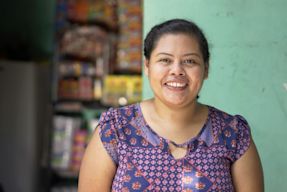From March 15 – 17, 2022, Kiva with support from USAID hosted a virtual Gender Equity + Financial Inclusion Forum (GEFI Forum), featuring discussions dedicated to advancing women’s economic empowerment and financial resilience. Bringing together investors, gender experts, and representatives from financial institutions and social enterprises, the GEFI Forum drew an audience of over 500 registrants from over 60 countries.
During the three-day Forum, participants and presenters tackled pressing issues facing gender equity in finance. The goal of the GEFI Forum was to not only create awareness around gender lens investing, but to also share innovative strategies and promote discussions aimed at closing the economic gender gap. One main session featured a discussion on “Participatory Product Design,” emphasizing the importance of elevating end stakeholder voices in order to create better financial products for women. This post shares highlights from the session. A link to view “Participatory Product Design: Elevating end stakeholder voices to create better financial products for women” in its entirety can be found below.
Participatory product design problem
For many years, the status quo among microfinance institutions (MFIs) was to take a universal design approach to financial products and services that did not differentiate across borrowers. However, as the microfinance industry has grown, developed, and become more competitive, MFIs and social enterprises today are increasingly recognizing the economic benefits of centering the client- especially women clients- within their product design process.
A panelist of experts
Rather than pushing for ‘one-size fits all’ design approach, the Participatory Product Design panelists, William Alemi Kenyi (BRAC Uganda Bank Limited), Kaylene Alvarez (Athena Global), Ramiro Rejas Carrera (60 Decibels), and Zainab Saeed (Kashf Foundation), discussed the importance of pushing for solutions that specifically address the pain points experienced by end beneficiaries. The engaging discussion, moderated by Stasi Baranoff (Kiva), emphasized that the key to participatory product design is keeping the end user’s needs at the center of the value chain. For Alvarez, acquiring and building trust among a customer base is too valuable to “just kind of throw products out into the market, and hope that that’s what they want.” Instead, “when women tell you what they want,” claimed Alvarez, “listen to them” so that products can be designed with an end user in mind.
Given that many MFIs around the world target low-income women, the panelists also emphasized that understanding the unique, gendered nature of women’s financial needs is crucial to the product design process. As the panelists pointed out, women are not a monolith with homogenized financial needs. Around the world, women demonstrate different financial circumstances, desires, and motivations; as a result, the financial products and services offered to women should reflect the heterogeneity of their financial needs. For Kashf, a microfinance institution in Pakistan that exclusively serves women, “gender is not an outcome or a byproduct of our product design,” claimed Saeed, “but it is something that we keep at the center.”
Panel recommendations and insights
So how can end beneficiary voices- particularly those of female end beneficiaries- be elevated in the product design process? Throughout the engaging session, all panelists spoke to the importance of collecting both quantitative and qualitative data on an ongoing basis to better understand the changing needs and preferences of the end client. However, when collecting client feedback, both Rejas and Saeed emphasized the importance of seeking multiple perspectives to ensure that the voices being heard are truly representative.
However, panelists pointed out that participatory product design is an ongoing process that does not stop after roll out. In fact, the importance of iteration emerged as a central theme. The benefit of lean data, Rejas explained, allows organizations to continue iterating, tweaking, and improving financial offerings to better address client pain points as they emerge. What’s more, iteration ensures that the financial products or services offered can meet the changing needs of end clients. “You have to understand that as life changes for us, it also changes for the clients,” said Saeed. “Clients are constantly going through life cycle changes,” and as a result it’s important to continuously pay attention to both market trends and client needs in an effort to “grow and adapt and change alongside their customers.”
Concluding thoughts
Strong participatory product design that elevates end stakeholder voices results in financial products and services that not only better address gendered barriers faced by women, but also increases organizational performance. Whereas Kenyi pointed out that implementing change based on client feedback “shows end beneficiaries that we are an entity that cares about them and values whatever feedback they give to us,” Alvarez noted that centering women clients’ needs and voices fosters trust and strengthens both new client uptake and retention across MFIs. Overall, the session revealed that designing around the demands of the client also fosters organizational scale, client loyalty, and a stronger market position. As Saeed pointed out, participatory product design is both “great for the client, and also the institution.”
Missed the live GEFI Forum session? Watch a recording of the virtual Participatory Product Design session to learn more.















